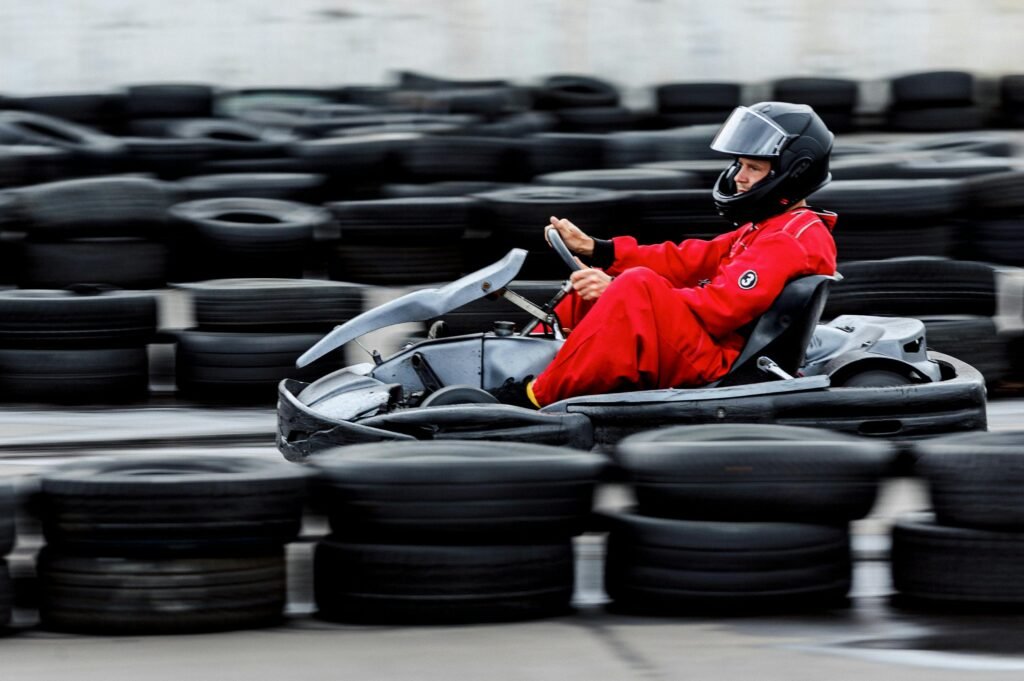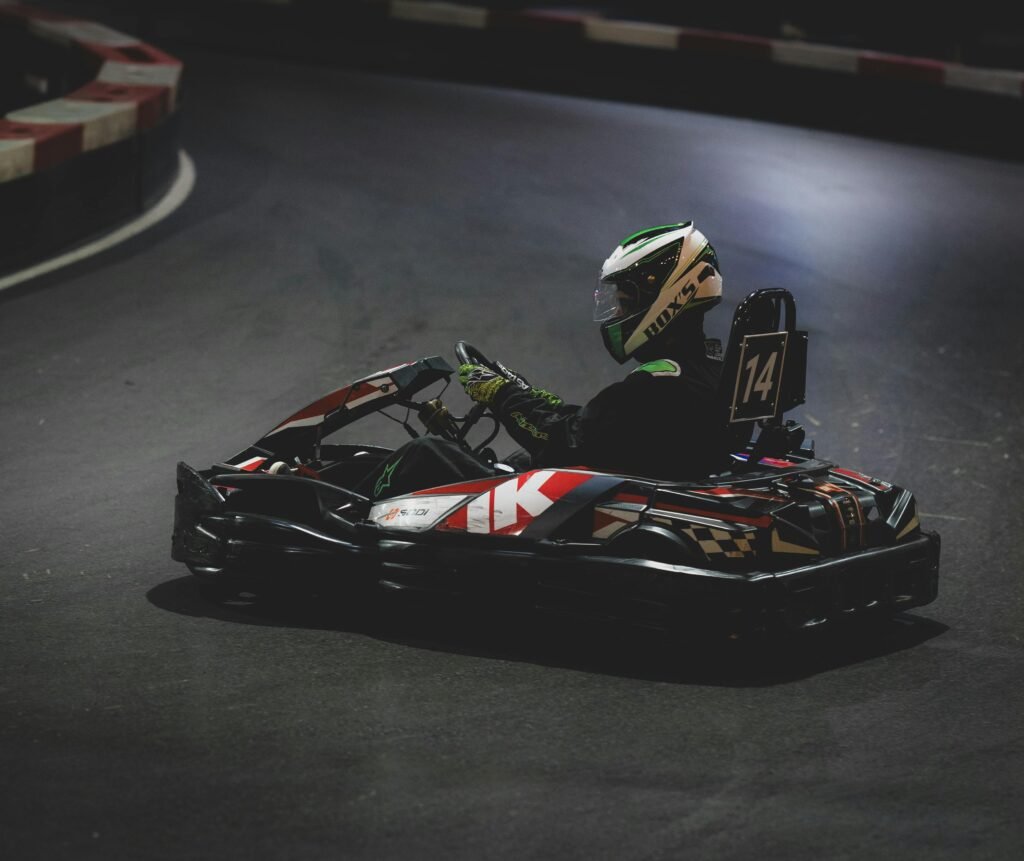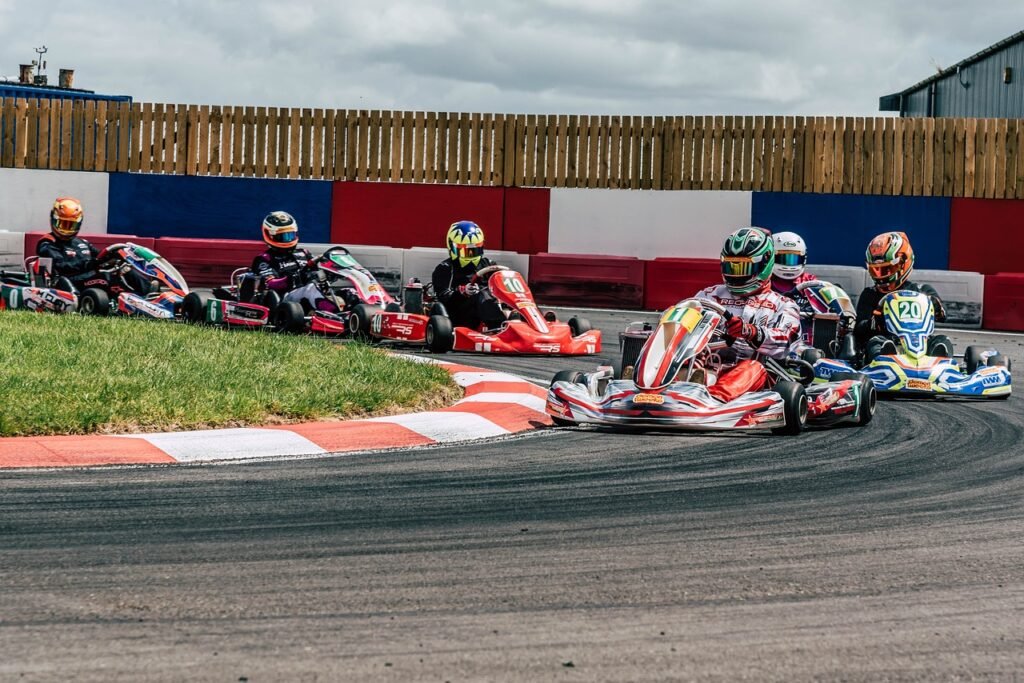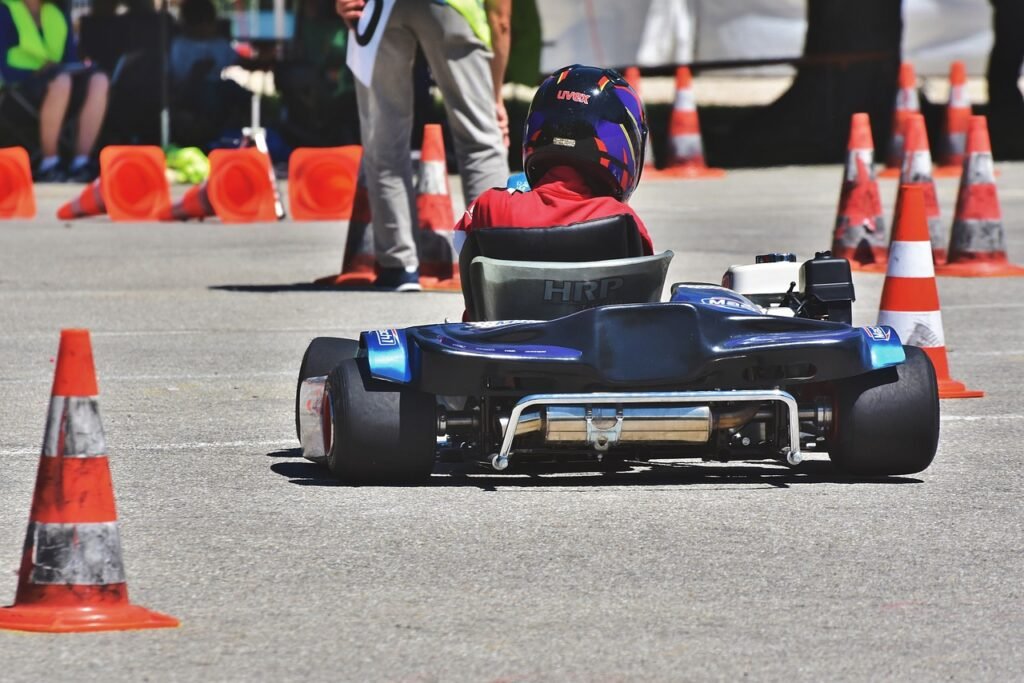Go-karting is an exhilarating and accessible way to experience the thrill of racing. Whether you’re looking for a fun day out with friends or considering it as a stepping stone to a professional racing career, this beginner’s guide will give you all the essential information to get started.
From understanding the basics to mastering key driving techniques and ensuring safety, this guide prepares you for your first time on the track.

1. What is Go-Karting?
Go-karting is a form of motorsport that involves driving small, four-wheeled vehicles, known as go-karts, around a designated track. Despite their compact design, go-karts can reach impressive speeds, providing both a fun and thrilling experience. Karting is often seen as the first step toward more advanced racing careers, including prestigious series like Formula 1 or NASCAR.
There are two primary types of go-karting:
- Recreational Karting: Found at amusement parks and dedicated karting tracks, recreational karting is designed for fun and casual racing. The karts typically have lower speeds, and the tracks are simplified for a more relaxed experience, making it perfect for beginners and families.
- Competitive Karting: This is a more serious sport involving faster karts, more complex tracks, and organized races. Competitive karting serves as a gateway to higher levels of motorsport, such as Formula 4 or karting championships, and is pursued by those aiming for professional racing careers.
For beginners, recreational karting is the best starting point. It allows you to get comfortable with driving a kart, practice basic racing skills, and learn how to navigate a track in a safe, controlled environment.
2. Choosing the Right Track and Kart
Selecting the right track and kart is crucial to having a successful and enjoyable go-karting experience, especially if it’s your first time. Your choice of karting center and track should align with your skill level and personal goals. Whether you’re looking for a casual experience or aiming to sharpen your driving skills, choosing wisely will set you up for a fun and safe outing.
Track Selection: Indoor vs. Outdoor
One of the first decisions you’ll make is whether to race on an indoor or outdoor track. Both have their unique characteristics, and each offers a different racing experience depending on your preferences and experience level.
- Indoor Tracks: These tracks are typically shorter, more technical, and have tighter corners, requiring drivers to focus on precision and control rather than speed. Since indoor tracks are in controlled environments, you won’t have to deal with weather conditions like rain or wind, making them a great choice for beginners. Indoor karting tends to emphasize technical driving skills, as the layout often demands sharp turns and quick adjustments. Beginners may find indoor tracks easier to navigate, allowing them to focus on mastering basic handling before moving on to more complex layouts.
- Outdoor Tracks: Outdoor karting tracks are usually longer and allow for higher speeds, providing a more authentic racing experience. These tracks often have longer straightaways where you can feel the thrill of speed, and they may include elevation changes or wider turns, giving you a more varied experience. However, outdoor tracks can be more challenging for beginners due to the potential for weather changes and less controlled conditions. The larger track size also means you’ll need to maintain concentration over a longer distance.

Kart Selection: Finding the Right Kart for Beginners
If you’re just starting out, it’s essential to choose a kart that matches your skill level. The type of kart you drive can significantly affect your experience, and for beginners, it’s best to start with a kart that’s easy to handle and not too fast.
- Four-Stroke Karts: Most karting centers offer four-stroke karts for beginners. These karts are less powerful than the more advanced two-stroke karts used in competitive racing, but they still provide plenty of speed to make your first go-karting experience exciting. Four-stroke engines are known for being more durable, easier to operate, and less prone to mechanical issues, making them ideal for learning the ropes. They typically have a smooth acceleration curve, allowing new drivers to focus on mastering control without being overwhelmed by sudden bursts of power.
- Rental Karts: When starting out, you don’t need to worry about buying your own go-kart. Most karting centers provide well-maintained rental karts that are suitable for all skill levels. These karts are designed to be durable and forgiving, which means they can handle the occasional bump or scrape without compromising performance. Rental karts are also equipped with basic safety features, such as seat belts and bumpers, to ensure a safe ride while you get comfortable on the track.
Pro Tip: Don’t feel pressured to upgrade to a more powerful kart too quickly. As you gain experience, you’ll naturally begin to crave more speed and responsiveness, but it’s essential to master the fundamentals first. Focus on learning basic racing techniques like braking, cornering, and throttle control before moving on to faster karts.
Track Safety and Preparation
When choosing a track, also consider the safety features it offers. Look for tracks that have clear safety guidelines, well-trained staff, and protective barriers around sharp corners or high-speed areas. Tracks that emphasize safety not only ensure a more enjoyable experience but also provide peace of mind, especially for beginners.
Before heading to the track, familiarize yourself with the karting center’s rules and regulations. Understanding their safety protocols, such as the proper use of helmets and seat belts, is critical for ensuring your safety on the track. Additionally, knowing basic etiquette—such as yielding to faster drivers and not cutting corners—will make the experience smoother and more enjoyable for everyone.
Key Takeaway: As a beginner, look for a karting center with beginner-friendly tracks and four-stroke karts, which are easier to handle and provide a balanced mix of speed and safety. Start on an indoor track to get comfortable in a controlled environment, and focus on mastering the basics before advancing to faster karts or outdoor tracks. Rental karts are the best option for starting out, offering you the perfect balance of fun and learning without the pressure of ownership.
3. Essential Go-Karting Gear
While go-karting is a fun and accessible sport, safety should always be the top priority. Luckily, you don’t need a lot of expensive gear to get started with recreational go-karting, but there are a few essential items you’ll need to ensure both comfort and protection while on the track.
1. Helmet
A helmet is the most important piece of safety gear in go-karting. Most karting centers will provide helmets for you, but if you plan to go karting regularly, investing in your own motorsport helmet is a great idea.
- Proper Fit: A snug-fitting helmet is crucial for protection. The helmet should sit level on your head, with no large gaps between your head and the helmet’s padding. It should be tight enough that it doesn’t move when you shake your head but not so tight that it causes discomfort.
- Type of Helmet: If you’re bringing your own, make sure it’s a DOT or Snell-approved helmet designed for motorsports. These helmets are specifically engineered to withstand high-speed impacts and provide better protection than standard bicycle helmets.

2. Racing Suit or Comfortable Clothing
When it comes to clothing, comfort and safety are key. While you don’t need a full racing suit for casual karting, wearing the right outfit will ensure you have a safer and more enjoyable experience.
- Close-fitting Clothes: Opt for fitted, comfortable clothes like long-sleeved shirts and pants. Avoid loose clothing like scarves, long shirts, or baggy pants, as they can easily get caught in the kart’s moving parts, which can be dangerous.
- Racing Suits: Some karting centers provide racing suits to protect you from scrapes or burns if you’re involved in a minor accident. These suits also provide some resistance against debris on outdoor tracks, keeping you cleaner and more protected during your race.
3. Gloves
Although gloves may not be mandatory at many karting centers, they are highly recommended. Racing gloves not only enhance your grip on the steering wheel—especially if your hands get sweaty—but also offer protection from blisters during long sessions.
- Grip and Control: Well-fitted gloves improve control and comfort while driving. Opt for gloves with reinforced palms and fingers for durability and a secure grip on the wheel.
4. Closed-Toe Shoes
Footwear is often overlooked, but wearing the right shoes can make a big difference in karting.
- Sneakers or Sports Shoes: It’s essential to wear closed-toe shoes that fit securely on your feet. Sneakers, tennis shoes, or sports shoes work best because they provide grip and support for controlling the throttle and brake pedals.
- What to Avoid: Steer clear of sandals, flip-flops, heels, or any open-toed shoes, as they don’t provide adequate protection or support. The last thing you want is for your foot to slip off the pedal in the middle of a race.
5. Pro Tip: Dress in Layers
Indoor tracks can sometimes be chilly due to air conditioning, while outdoor tracks may expose you to varying weather conditions. Dressing in layers allows you to adapt to the environment, keeping you comfortable throughout your session. You can easily remove a layer if it gets too warm or add one if it’s cold, ensuring an optimal racing experience.
4. Understanding Kart Controls
Before hopping into your go-kart, it’s essential to familiarize yourself with the basic controls. Most rental karts are designed for simplicity and ease of use, often featuring automatic transmissions, which means there’s no need to worry about shifting gears. However, understanding the key elements of kart control will help you drive more smoothly and confidently.
1. Steering Wheel
The steering wheel is the main tool for directing your kart. Unlike regular cars, go-karts have very sensitive steering, which means that small movements can lead to sharp turns.
- Quick Response: Be mindful that over-steering or jerky movements can lead to loss of control. Practice making smooth, deliberate turns with the steering wheel to maintain stability and keep your kart on the right racing line.
- Hand Positioning: Keep your hands at 9 and 3 o’clock positions on the wheel. This gives you better control and allows for quick corrections, especially in tight corners.
2. Throttle (Right Pedal)
The throttle—or gas pedal—is located on the right side. This pedal controls your speed, and the more you press it, the faster the kart will go.
- Smooth Acceleration: Rather than stomping down on the throttle, practice using smooth, gradual pressure to control your acceleration. This makes the kart more stable, especially when exiting corners.
- Controlled Speed: While it’s tempting to go full throttle the entire race, controlling your speed with careful use of the gas pedal can help you navigate turns more efficiently, resulting in better lap times.
3. Brake (Left Pedal)
The brake pedal is located on the left side of the kart. Braking is key to maintaining control during sharp corners and slowing down safely.
- Separate Controls: One of the most important rules in go-karting is to never press the brake and throttle at the same time. Doing so can damage the kart and cause you to lose control. Use one pedal at a time to ensure smooth transitions between speeding up and slowing down.
- Progressive Braking: Apply the brake gradually rather than slamming down on it. Sudden braking can cause your kart to skid or spin out, especially in corners. Practicing smooth braking will give you better control of your kart and improve your racing performance.
4. Pro Tip: Smooth Inputs for Better Control
The key to mastering karting is using smooth, controlled inputs on both the throttle and brake pedals. Avoid slamming or jerking the controls, as this can lead to skidding or losing control. Smooth acceleration and braking lead to more stability, faster lap times, and a more enjoyable driving experience. Focus on keeping your movements fluid, especially when navigating corners or overtaking other drivers.

5. Basic Karting Techniques
Once you’ve familiarized yourself with the controls, it’s time to put your skills to the test on the track! Mastering basic karting techniques is crucial for improving your performance, ensuring safety, and making the most of your karting experience. Here are some fundamental driving techniques to help you get started on the right foot:
1. Cornering
Cornering efficiently is one of the most critical skills in karting. Following the racing line—the optimal path around the track—will help you maintain speed, reduce lap times, and enhance control during sharp turns.
- Approach wide: As you approach a corner, start from the outside edge of the track. This wider entry gives you more room to maneuver and maintain speed.
- Hit the apex: Midway through the corner, aim for the apex—the point on the inside edge of the corner where you’re closest to the curb. By clipping the apex, you’ll shorten the distance through the turn while maximizing control.
- Exit wide: After hitting the apex, gradually drift back to the outside edge of the track as you exit the corner. This technique ensures that you maintain momentum while exiting the turn, giving you a smoother transition back to the straight.
- Pro Tip: Visualize the corner as a wide arc rather than a sharp angle. This allows for smoother cornering and reduces the risk of losing control.
2. Braking
Effective braking is essential for navigating the track with confidence. Unlike driving a regular car, kart braking requires precise timing and control to maintain stability during high-speed races.
- Brake early and hard: Apply the brakes firmly before entering a corner. Braking early allows you to reduce your speed while still maintaining control.
- Release gradually: Once you’ve slowed down, release the brake smoothly as you start steering into the corner. This will allow the kart to glide through the turn without jerking or losing grip.
- Avoid braking mid-turn: Braking while turning can cause your kart to lose traction and spin out. Always complete your braking before entering the corner to maintain control.
- Pro Tip: Practice threshold braking—applying maximum brake pressure without locking up the tires. This will improve your lap times by allowing you to brake later and maintain speed.
3. Acceleration
Just as with braking, smooth acceleration is key to controlling your kart. Accelerating too hard out of a corner can cause your kart to lose grip, while gentle, controlled acceleration helps you maintain stability and speed.
- Gradual throttle control: As you exit a corner, gradually press the throttle to increase speed without losing control. This will help you maintain traction and build speed as you enter the straight.
- Pro Tip: Avoid slamming on the gas immediately after a turn. Smooth, controlled inputs will lead to faster lap times and better overall handling.
6. Safety Tips for Beginners
While karting is an adrenaline-filled sport, safety should always be a top priority, especially for beginners. Understanding and following proper safety protocols not only ensures your well-being but also contributes to a positive racing experience for everyone on the track.

1. Follow the Track Rules
Every karting center has its own set of safety guidelines and rules to follow. These are designed to keep both drivers and spectators safe. Pay attention to the safety briefing before you hit the track and ensure you understand the basic regulations, such as flag signals and speed limits in the pit area.
2. Respect the Other Drivers
Karting is a competitive sport, but it’s important to respect your fellow drivers. Avoid unnecessary collisions or aggressive driving, as this can lead to accidents or injury. Always maintain a safe distance from other karts, especially when navigating corners or preparing for overtakes.
3. Don’t Overestimate Your Abilities
As tempting as it may be to push the limits of your kart, it’s important to recognize your current skill level. Start slow and gradually build up speed as you gain confidence. Pushing too hard too early can result in loss of control, crashes, or spinouts.
4. Know the Flag Signals
Familiarize yourself with the track’s flag signals, which are used to communicate important information during a race. For instance, a yellow flag signals caution, while a red flag indicates that the race has been stopped. Pay attention to these signals to stay safe and follow the track marshal’s instructions.
- Pro Tip: If you see a blue flag, it means a faster driver is approaching, and you should yield to allow them to pass.
7. Tips for Improving Your Skills
As you become more comfortable with karting, you’ll likely want to focus on improving your technique and lap times. Here are some tips to help you progress from beginner to confident driver:
1. Observe Experienced Drivers
Watching experienced drivers can teach you a lot about karting. Whether you’re observing fellow racers on the track or watching instructional videos online, pay attention to how they navigate corners, their braking points, and how they accelerate out of turns. Try to emulate these techniques in your next session.
2. Practice Makes Perfect
The best way to improve your skills is through consistent practice. The more time you spend on the track, the better you’ll understand the nuances of kart handling, cornering, and strategy. Don’t be afraid to make mistakes—learning from them will help you refine your technique.
3. Focus on Consistency
Rather than chasing speed alone, focus on driving smoothly and consistently. Hitting the same braking points, maintaining the racing line, and improving corner exits will naturally lead to faster lap times.
- Pro Tip: Many karting tracks offer time trials, where you can compare your lap times with others. Use these trials to track your progress and identify areas where you can improve.

8. Take it Further with Competitive Karting
Once you’ve mastered the basics of karting and want to take your skills to the next level, you can explore competitive karting. This exciting step involves participating in leagues, competitions, and more structured racing events that challenge your technique, speed, and strategy.
1. Join a Local Karting Club
Joining a local karting club, for example Aruani Grid Motorsports Academy in Bangalore is a great way to immerse yourself in the competitive side of the sport. Clubs often organize regular races, training sessions, and social events for karting enthusiasts, offering plenty of opportunities to improve your skills and make connections in the racing community.
2. Invest in Your Own Kart
As you advance in karting, investing in your own kart allows for more customization and performance tuning. Owning your own kart gives you more control over key factors such as tire selection, gear ratios, and chassis setup, enabling you to optimize your kart for specific tracks and conditions.
3. Look into Karting Schools
If you’re serious about advancing in the sport, consider enrolling in a professional karting school. These programs are designed to help drivers refine their techniques, learn advanced racing strategies, and prepare for higher levels of competition.
Ready to Hit the Track?
Go-karting is an exciting way to experience the thrill of motorsports, whether you’re racing for fun or aiming for a competitive career. Starting with the basics—like mastering kart control, learning proper cornering techniques, and following safety protocols—will set you up for success on the track. As you gain experience, focus on improving your skills through practice, observation, and consistency.
Start with your first karting session, and who knows, it might just be the beginning of your journey into the world of motorsports!
